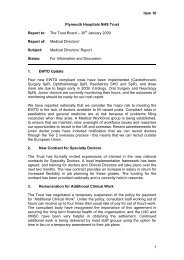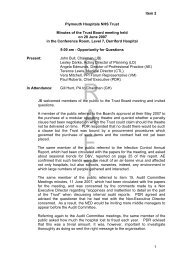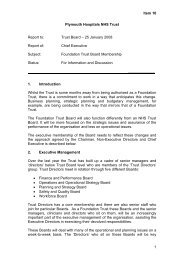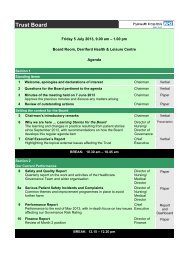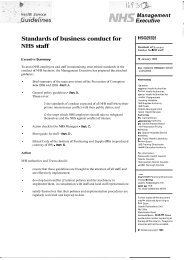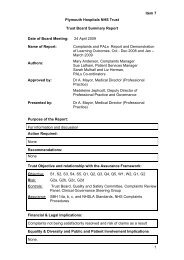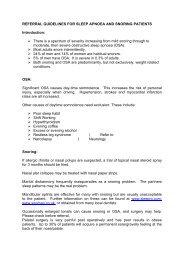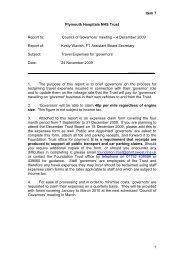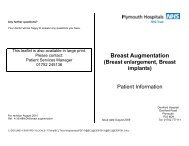IVF & ICSI INFORMATION BOOKLET - Plymouth Hospitals
IVF & ICSI INFORMATION BOOKLET - Plymouth Hospitals
IVF & ICSI INFORMATION BOOKLET - Plymouth Hospitals
Create successful ePaper yourself
Turn your PDF publications into a flip-book with our unique Google optimized e-Paper software.
Assisted Conception Information Booklet<br />
<strong>IVF</strong> & <strong>ICSI</strong> <strong>INFORMATION</strong> <strong>BOOKLET</strong><br />
SOUTH WEST CENTRE FOR REPRODUCTIVE MEDICINE<br />
OCEAN SUITE - LEVEL 6<br />
Derriford Hospital<br />
<strong>Plymouth</strong> PL6 8DH<br />
Tel. (01752) 763704 : Fax (01752) 763641<br />
e-mail: jackie.waugh@phnt.swest.nhs.uk - www.derriford.co.uk/ivf<br />
THE UNIT<br />
The South West Centre for Reproductive Medicine has been established to provide a full<br />
range of investigations and treatment for couples experiencing infertility. It is housed in<br />
purpose built premises on Level 06, Women’s Health Services Derriford Hospital, and has<br />
incorporated all previous infertility services with the addition of the Assisted Conception<br />
Unit providing the most up to date treatments. We offer preliminary investigations,<br />
ovulation induction, secondary sperm function testing, intrauterine inseminations, donor<br />
sperm treatment, in vitro fertilisation (<strong>IVF</strong>), intracytoplasmic sperm injection (<strong>ICSI</strong>),<br />
assisted hatching, oöcyte donation, and freezing of sperm and embryos. The Centre is<br />
fully licensed by the Human Fertilisation and Embryology Authority and all work is carried<br />
out in accordance with the Human Fertilisation and Embryology Act and the Authority’s<br />
Code of Practice.<br />
THE TEAM<br />
The team includes senior medical, nursing, scientific and secretarial staff that have many<br />
years of experience in infertility treatment. Our expertise and knowledge has been<br />
accumulated in some of the best Units in the UK.<br />
We, as a team, believe in providing the highest quality of treatment and care while<br />
understanding the anxieties and concerns of the couple. We offer a caring sensitive<br />
approach within a dedicated and knowledgeable team who appreciate the nature<br />
and problems of infertility, both physical and emotional.<br />
NATURAL CONCEPTION<br />
Every month an egg is released from the ovary and moves slowly down the Fallopian<br />
tubes (tubes) towards the uterus (womb). If sperm have been released in the vagina<br />
during intercourse within the previous day or two these may have swum up to the tubes<br />
where they attempt to combine with the egg. If this union is successful, the fertilised egg<br />
continues along its path to the womb growing along the way. After 5 days, the embryo (as<br />
it is now called) begins to implant in the lining of the uterus. If this implantation is<br />
successful and the embryo establishes itself well, a pregnancy will result. If no sperm<br />
were present, or they did not fertilise the egg, the egg will continue towards the womb, be<br />
expelled and a period will begin (two weeks after the egg was first released).<br />
WHAT IS <strong>IVF</strong>?<br />
In vitro fertilisation (<strong>IVF</strong>) is a phrase, which describes the process by which the oöcyte or<br />
egg is fertilised by the sperm outside the body. Originally, this was carried out in glass<br />
dishes, which is how the term “in vitro” arose, as this literally means “in glass”. <strong>IVF</strong><br />
involves the collection of eggs and sperm, which are then mixed in the laboratory under<br />
strictly controlled conditions.<br />
P.I. 1.3-Assisted Conception Information Booklet-V:7 Jan10 SD/AL/UA Page 1 of 11
Assisted Conception Information Booklet<br />
The eggs, which fertilise normally, are left to grow for a further day or two to check that<br />
they are developing normally. In most women a maximum of two embryos are replaced in<br />
the womb (although the law allows us to replace up to three in patients over the age of 40),<br />
and if there are remaining embryos, which are of suitable quality, they may be frozen. The<br />
frozen embryos can be thawed and replaced at a future time.<br />
WHAT IS <strong>ICSI</strong>?<br />
<strong>ICSI</strong> stands for intracytoplasmic sperm injection and is a technique used for male factor<br />
causes of infertility such as a very low sperm count. The process is very similar to that in<br />
<strong>IVF</strong> cases, but the difference is that a sperm is injected directly inside each egg. By<br />
placing the sperm inside the egg it gives an opportunity for fertilisation to occur where it is<br />
not possible naturally due to poor sperm quality. This is still a relatively new technique that<br />
has been used routinely in the UK since the early to mid 1990’s.<br />
WHO CAN BENEFIT FROM <strong>IVF</strong> AND <strong>ICSI</strong>?<br />
Couples having difficulty conceiving a child may be having a problem in any or several of<br />
the steps involved in natural conception. <strong>IVF</strong> and/or <strong>ICSI</strong> can help many couples including<br />
those in which the woman has blocked, damaged, or no fallopian tubes; the woman has<br />
the condition called endometriosis; the man has a reduced sperm count; the woman has<br />
problems ovulating or no cause of infertility has been found.<br />
PATIENTS WE TREAT<br />
We recommend that to increase your chances of a successful treatment that you are the<br />
right weight for your height. A measurement used to help assess if you are within a healthy<br />
range is called Body Mass Index (BMI). A member of our team can work this out for you.<br />
Excess weight may not only reduce your chance of success but in extreme cases is<br />
associated with a significant health risk to both mother and baby.<br />
Please also note that NHS funding for some of the more expensive treatments, such as<br />
intrauterine insemination (IUI), ovulation stimulation using a course of injections, and invitro<br />
fertilisation (<strong>IVF</strong>) is currently restricted to couples that fulfil criteria set down by their<br />
local Primary Care Trusts (the organisations responsible for NHS funding). For residents of<br />
Devon & Cornwall these include: more stringent body weight requirements (BMI less than<br />
30); the woman should be a non-smoker and her partner advised likewise; the woman’s<br />
age should be under 40 and neither the man nor the woman should have any existing<br />
children. Eligibility for this NHS funded treatment also has to be validated and approved.<br />
At the present time we are able to offer NHS funded <strong>IVF</strong> to women if the level of an Anti<br />
Mullerian Hormone (AMH) blood test is at a level where stimulation is likely to be<br />
successful. When couples request treatment, we are by law required to take in to account<br />
the welfare of a future child. Our unit policy is to assess each couple individually.<br />
At present our age limits for treatment are 19 to 45 years of age. If there are oncology<br />
patients who need treatment then the lower limit may be not adhered to due to this group<br />
of patient’s special needs.<br />
WHAT ARE THE NEXT STEPS?<br />
If you are interested in having <strong>IVF</strong> treatment with us, we request that you obtain a letter of<br />
referral to the Unit from your GP. Your GP will initiate some tests prior to your first<br />
appointment.<br />
P.I. 1.3-Assisted Conception Information Booklet-V:7 Jan10 SD/AL/UA Page 2 of 11
Assisted Conception Information Booklet<br />
We will send you some more detailed information and a consent booklet which you will<br />
need to read through carefully and sign during your consultation and before beginning<br />
your treatment. Signing the consent form does not commit you to treatment and you are<br />
free to change your mind at any time.<br />
Please read everything carefully and if there are any things you do not understand or if you<br />
have any questions make a note of them and ask them at your first visit.<br />
Both partners should come for the first consultation, which may take about an hour in total.<br />
During this visit we will take your medical history, explain the treatment, and ask for some<br />
background information about yourselves and your relationship.<br />
THE TREATMENT<br />
There are four main stages, which <strong>IVF</strong> requires.<br />
1. The use of special hormones to stimulate the ovaries to produce more than one egg.<br />
2. Collecting the eggs from the ovaries. This is usually performed under sedation.<br />
3. Preparation of the sperm sample for mixing with the eggs on the day of egg collection.<br />
4. Replacement of fertilised eggs (embryos) into the womb.<br />
During a natural cycle the ovary produces one and occasionally two eggs. For <strong>IVF</strong> the<br />
production of a greater number of eggs increases the chances of success and the ovaries<br />
can be “stimulated” to produce more eggs. The stimulation of the ovaries is achieved with<br />
hormones that are the same ones normally produced by the body. These hormones<br />
cannot be taken orally (by mouth) as they are digested and destroyed in the stomach and<br />
would not have any effect on the ovaries. These hormones are administered by injection<br />
and the clinic will instruct you on how to use and take these hormones.<br />
DOWN-REGULATION<br />
The first stage of stimulating the ovary is to suppress the woman’s own hormone<br />
production in the pituitary gland (a small gland at the base of the brain which controls the<br />
ovaries). Switching off the pituitary prevents any activity within the body, which could<br />
interfere with the stimulation procedure. These drugs are called gonadotrophin releasing<br />
hormone agonist (GnRH-a) or antagonists. Treatment is usually started following a period<br />
of taking the contraceptive pill and continues right up until the day of egg collection.<br />
The GnRH-a can be taken by nasal spray, depot injection (once a month) or daily<br />
subcutaneous injections. Exact instructions will be given by the clinic when your treatment<br />
starts. Side effects, which may be experienced with these drugs, are described below. A<br />
few days after starting GnRH-a treatment a period should occur. This signifies that the<br />
pituitary has been suppressed, called down-regulation.<br />
STIMULATION<br />
After down-regulation has been achieved further hormones will be given in specific and<br />
timed daily doses, which will stimulate the ovaries. There are various types and brands<br />
that can be used and details will be given by the clinic when treatment begins. These<br />
hormones are given by injection under the skin. Each woman will respond slightly<br />
differently to these hormones and will be carefully monitored by the clinic. This is done by<br />
regular ultrasound scans (to look at and measure the ovaries). The ultrasound scan is<br />
performed using a small probe in the vagina from which the ovaries can be clearly seen.<br />
Ovaries contain follicles, which are small fluid filled sacs. These grow and develop in<br />
response to the stimulation hormones. As the follicles grow and develop so does the egg<br />
that is contained within the follicle (not every follicle will contain an egg).<br />
P.I. 1.3-Assisted Conception Information Booklet-V:7 Jan10 SD/AL/UA Page 3 of 11
Assisted Conception Information Booklet<br />
At a suitable time when there has been enough stimulation of the ovaries a final injection is<br />
given which will cause the eggs to finish developing. This is called the human chorionic<br />
gonadotrophin (hCG). The clinic will instruct you to have this injection at a specific time,<br />
usually at night. It is very important that you have this injection at the time instructed<br />
because this is necessary to make sure that the eggs are well developed and can be<br />
collected. If you take this injection at the wrong time, we may not be able to collect any<br />
eggs or they may not be mature and the treatment will be compromised.<br />
EGG COLLECTION<br />
The mature eggs are removed from the follicles so that they can be mixed with sperm in<br />
the laboratory. The egg collection is usually carried out in the Assisted Conception Unit<br />
under sedation, which is a sleepy state where you may feel some discomfort but will not be<br />
knocked out. An ultrasound machine is used to watch the ovaries while the eggs are<br />
being removed. Your partner is welcome to be present at the time of egg collection.<br />
As the ovaries have been stimulated they become enlarged and lie close to the top of the<br />
vagina. The egg collection is done with a fine needle, which is attached to a special guide<br />
on the ultrasound probe. The needle is passed through the wall of the vagina into the<br />
ovaries, which can be seen, on the ultrasound scan. The tip of the needle can be seen on<br />
the ultrasound and is placed in each follicle to remove the contents, which will also,<br />
hopefully, contain an egg. Every single follicle does not contain an egg and so there may<br />
be fewer eggs than the total number of follicles seen during the stimulation of the ovary.<br />
The fluid collected from the follicles is passed to the Embryologist who will look at it under<br />
the microscope and find the eggs. The eggs are then put in a special fluid (culture<br />
medium) and placed in an incubator for a few hours prior to insemination.<br />
SPERM COLLECTION<br />
On the day of egg collection a sperm sample is required, usually around the same time as<br />
the egg collection. The man should abstain from intercourse (ejaculation) for 2-5 days<br />
before the egg collection. Abstaining for shorter (less than 2 days) or longer (more than 5<br />
days) periods can affect sperm quality and should be avoided. The sperm sample will be<br />
prepared to obtain a sample with many motile sperm, which are the sperm capable of<br />
getting to, attaching and hopefully fertilising an egg. The prepared sperm are then mixed<br />
with the eggs. The eggs will then be checked the following morning at which time the<br />
Embryologist will be able to find out how many eggs were fertilised. Occasionally, and<br />
unexpectedly, the eggs may not fertilise. The failure to fertilise may occur even if the eggs<br />
and sperm do not appear to have any problems.<br />
INTRACYTOPLASMIC SPERM INJECTION<br />
If there are sperm problems (low sperm count etc) then there may not be enough sperm to<br />
mix with eggs to achieve fertilisation. In this case the procedure of intracytoplasmic sperm<br />
injection (<strong>ICSI</strong>) is carried out. The sperm are injected into the egg and this improves the<br />
chances of fertilisation for couples with very low sperm numbers or no sperm in the<br />
ejaculate. The eggs are collected as described above and if they are sufficiently mature a<br />
single sperm will be injected into each egg. The egg is held with a fine glass pipette and a<br />
single sperm is identified and picked up with a very fine glass needle. The needle is then<br />
gently pushed into the egg and the sperm released. The injection needle is gently<br />
removed and the egg put away in the incubator.<br />
P.I. 1.3-Assisted Conception Information Booklet-V:7 Jan10 SD/AL/UA Page 4 of 11
Assisted Conception Information Booklet<br />
The eggs are left overnight in the incubator and checked the following morning for<br />
fertilisation. As a needle is being placed in the egg, there is a risk of damage to the egg,<br />
which is expected to be around 10-15%, although in some cases the eggs may be more<br />
fragile and damage more easily.<br />
Although there have been many babies born from this treatment, the first was only born in<br />
1992 and therefore the long term safety of this technique is still not fully known.<br />
Recent publicity regarding the risks associated with assisted conception techniques<br />
(<strong>IVF</strong>/<strong>ICSI</strong>) implied there is a slight increased risk of genetic/birth defects.<br />
The risk of birth defects in the general population is low, 2% of children born in Europe are<br />
born with birth defects. Some research has suggested that there might be an increased<br />
risk for babies born as a result of <strong>IVF</strong>/<strong>ICSI</strong>. This risk rises to 2.6%, which is still very low.<br />
However, the research cannot say with absolute certainty that this increase risk is due to<br />
the use of assisted conception techniques rather than other causes such as the age of the<br />
patient and the cause of infertility.<br />
TRAINING WITH EGGS, SPERM & EMBRYOS<br />
Consent will be sought from you to allow the lab to use any spare unfertilised eggs or<br />
spare embryos, or sperm samples for the training of laboratory staff in techniques such as<br />
<strong>ICSI</strong> (as above) or for the development of new techniques and services e.g new embryo<br />
freezing techniques. Only eggs, and embryos that are unsuitable for your treatment or<br />
storage will be used. No sperm will be inseminated or injected into any eggs. If you have<br />
any further questions regarding the use of your samples in training then please ask to<br />
speak to a member of the lab team.<br />
SPERM CRYOPRESERVATION:<br />
In <strong>ICSI</strong> although fewer sperm are needed than for conventional <strong>IVF</strong>, we do require a<br />
certain number of sperm to enable viable sperm to be selected for injection. For some<br />
couples therefore it is advisable to cryopreserve sperm samples prior to treatment. This is<br />
to ensure that on the day of egg collection sufficient sperm are available for the injection<br />
procedure. There is a charge for sperm freezing. Please ask the staff for current price<br />
details.<br />
Prior to sperm freezing the male partner is required to complete a consent form, which is<br />
issued by the HFEA. This form is a legal requirement giving your consent to freezing and<br />
also specifies your wishes as to the outcome of the frozen sperm if anything untoward<br />
were to happen to you. HFEA requirements also mean you will have routine screening for<br />
Hepatitis B, C and HIV.<br />
EMBRYO GROWTH<br />
The fertilised eggs are placed in the incubator for a total of 2 or 3 days after egg collection.<br />
The embryo will be checked to see that they are growing as expected. The egg starts off<br />
with one cell which splits into two which each split and so on until about 6-8 cells can be<br />
seen on the third day. The embryos are “graded” on their appearance, which is an<br />
indicator of how well they are expected to continue to grow. The grading is a guide only as<br />
technology is not yet at the stage where we can predict which embryo will result in a<br />
successful pregnancy.<br />
P.I. 1.3-Assisted Conception Information Booklet-V:7 Jan10 SD/AL/UA Page 5 of 11
Assisted Conception Information Booklet<br />
EMBRYO TRANSFER<br />
The embryo(s) are replaced in the womb with a soft fine plastic tube (catheter). This is a<br />
fairly simple procedure similar to a smear test. No anaesthetic is required and the<br />
procedure should not cause any discomfort. The neck of the womb (cervix) is viewed with<br />
a speculum (also used during smear tests) in the vagina and the cervix is then cleaned<br />
with a damp swab. The Embryologist loads the embryos into the catheter. The catheter is<br />
then passed gently into the womb and the embryos carefully released.<br />
Occasionally there may be a problem in getting the very soft catheter through the small<br />
neck of the womb and the Doctor may use an instrument to help him get the embryos<br />
transferred. This is not a common problem but there is some discomfort when this<br />
instrument is used. However, it is very important to get the embryos in the womb as<br />
quickly and as smoothly as possible, which is why the Doctor will try these other methods.<br />
AFTER EMBRYO TRANSFER<br />
As the pituitary has been down-regulated the woman will need some hormonal support<br />
after the embryo transfer. This will usually be given in the form of vaginal or rectal<br />
pessaries (progesterone). If the embryo or embryos successfully implant and establish a<br />
pregnancy you should not expect a period. A pregnancy can first be detected two weeks<br />
after the embryo transfer, usually by means of a urine test, which you can do at home. If<br />
there is some bleeding at the end of two the week period this could mean that no<br />
pregnancy has been established. If a urine test for pregnancy is positive then a scan will<br />
be arranged to confirm the pregnancy.<br />
POSSIBLE SIDE EFFECTS<br />
The hormones taken may cause the following side effects.<br />
• The GnRH-a hormones cause down-regulation by switching off the pituitary, which is<br />
similar to the changes, which happen after the menopause (change of life). Therefore<br />
the side effects, which may be experienced, are similar to some of the experiences of<br />
the menopause. GnRH-a may cause hot flushes, irritability, headaches or depression.<br />
These symptoms should ease and disappear when the stimulation hormones are<br />
taken.<br />
• A few women may over respond to the stimulation hormones, which will be recognised<br />
during the careful monitoring. This response can lead to a condition called ovarian<br />
hyperstimulation syndrome (OHSS). If left unattended the consequences of OHSS can<br />
be very severe including death. In severe cases the ovaries become enlarged and<br />
there is fluid retention in the abdomen (stomach area), which can cause pain or<br />
discomfort. There may also be diarrhoea, nausea, vomiting, reduced urine output,<br />
thirst, breathlessness and a feeling of faintness or weakness. This is a rare<br />
complication. If you have difficulties, please get in touch with the unit rather than any<br />
other hospital doctor or your GP. If you are experiencing these symptoms telephone<br />
Derriford switchboard on 0845 1558155 and ask for the <strong>IVF</strong> Sister to be paged. In<br />
case of emergencies, a Sister is on call 24 hours a day.<br />
• As a result of ovarian stimulation treatment, there maybe a possible association<br />
between this and ovarian cancer but evidence from research studies has been<br />
contradictory. Recently, a large population study from Denmark published in February<br />
2009, found no convincing association between the use of fertility drugs and risk of<br />
ovarian cancer.<br />
P.I. 1.3-Assisted Conception Information Booklet-V:7 Jan10 SD/AL/UA Page 6 of 11
Assisted Conception Information Booklet<br />
POSSIBLE PROBLEMS<br />
There are several steps involved in the <strong>IVF</strong> treatment beginning with down-regulation,<br />
ovarian stimulation, egg collection, sperm preparation, fertilisation, embryo transfer and<br />
embryo freezing (if performed). Although most couples will proceed through most of these<br />
stages there is a chance that one or several of these steps may not work.<br />
• For example, the ovaries may not stimulate well and the hormone doses can be<br />
adjusted to try and improve the response sometimes, however, the response does not<br />
improve and we may advise you to cancel your treatment cycle.<br />
• After egg collection there is a small chance of an infection. To reduce this risk we will<br />
administer some antibiotic cover just prior to your egg collection. Some patients<br />
experience some bleeding from the needle site in the vagina. This usually subsides<br />
quickly.<br />
• There is a small chance that there may not be any eggs collected. However, this is<br />
rare and we will usually get at least one egg from a woman. Once the eggs are<br />
collected they are then taken to the lab and mixed with the sperm of your partner or a<br />
donor, whichever treatment you have consented to. There is a possibility that the eggs<br />
may not fertilise or that they may not develop well and there will not be an embryo<br />
transfer. We are not able to predict how the eggs will develop until then, but we can<br />
use the information from other treatments to help us improve the result of the next<br />
treatment, if you were to come back.<br />
• If all the steps proceed satisfactorily the final outcome is still not guaranteed, that is a<br />
pregnancy is established. Pregnancies established after <strong>IVF</strong> are still exposed to the<br />
same antenatal risks as natural pregnancies such as miscarriage or abnormalities.<br />
Although there do not seem to be any greater problems during pregnancies between<br />
women conceiving naturally or from <strong>IVF</strong>, women having <strong>IVF</strong> tend to be slightly older,<br />
which in itself is associated greater risks during pregnancy.<br />
• Normally we only replace only 1 or 2 embryos in line with current HFEA directives. In<br />
women over the age of 40 up to three embryos may be replaced in the womb. There is<br />
a chance that if you become pregnant there may be more than one baby; a multiple<br />
pregnancy. Multiple pregnancy places a greater physical strain on the mother as well<br />
as increasing the risk of complications such as miscarriage and premature delivery<br />
(before the due date). Also, the mother is more likely to have to be admitted to<br />
hospital. The average pregnancy is 34 weeks for triplets (three babies), which is 4-6<br />
weeks earlier than the due date. These babies often have to stay in the intensive care<br />
unit for up to a month and if they progress well they have many hurdles in front of them.<br />
Depending on the maturity and weight some babies do not survive. Looking after twins<br />
or triplets is very demanding especially for the first three years and the parents face<br />
chronic tiredness, anxieties, tensions and a strain on their relationship. The costs of<br />
looking after more than one baby should also be considered.<br />
OTHER<br />
As a unit we endeavour to use high quality, safe and licensed equipment in the assisted<br />
conception processes. In addition, we as with many units use “off label” consumables. This<br />
means that products are used for purposes other than those specified by the<br />
manufacturer. As a unit we risk assess and batch test equipment as appropriate and<br />
frequently audit our results and success rates.<br />
P.I. 1.3-Assisted Conception Information Booklet-V:7 Jan10 SD/AL/UA Page 7 of 11
Assisted Conception Information Booklet<br />
EMBRYO FREEZING<br />
Following your embryo transfer if your remaining embryos are of a suitable quality, they<br />
may be frozen. Freezing embryos is a way of preventing them from perishing and using<br />
them at a later date. However, not all embryos survive the freezing and thawing process<br />
but it is hoped that approximately 70% (two out of three) of the embryos will survive the<br />
process. Only good quality embryos will be frozen, usually we require at least three, as<br />
these are expected to have a better chance of surviving the freeze-thaw process.<br />
Frozen embryos are stored in tanks containing liquid nitrogen and these are monitored<br />
with alarms and are checked regularly. It is very unlikely that any problem will occur<br />
during the freezing, storage or thawing period. However, if a problem does arise, the<br />
Assisted Conception Unit cannot be held liable. Every effort is taken to ensure that<br />
problems do not arise and that the embryos will be frozen stored and thawed successfully.<br />
REPLACEMENT OF FROZEN EMBRYOS<br />
Frozen embryos can either be replaced during a natural or stimulated cycle. Medical or<br />
nursing staff will give details of this to you. We ask that you wait for at least 2-3 months<br />
after your first <strong>IVF</strong> attempt before coming back for your frozen embryos to be replaced.<br />
This gives the woman’s body time to recover from the hormone and other treatments of<br />
the <strong>IVF</strong> cycle. Some people are worried that there could be damage to the embryo, which<br />
could result in an abnormal baby. At the moment the number of babies born from<br />
frozen/thawed embryos is still quite small but there does not seem to be any increased<br />
birth problems or defects. However, as with any <strong>IVF</strong> treatment, there can be no guarantee<br />
about the outcome.<br />
There is an additional charge for freezing embryos and for the subsequent thawing and<br />
replacement of the embryos. There is an annual charge for every year the embryos are<br />
kept cryopreserved.<br />
COUNSELLING<br />
The steps and treatments required during <strong>IVF</strong> are very intensive, with several visits, many<br />
injections and sometimes unexpected problems that can all be very demanding and<br />
draining on both partners. It has often been a long road to <strong>IVF</strong> treatment, with many<br />
intrusive and uncomfortable investigations, which are often described as a roller coaster.<br />
Family and friends may add to the pressure, usually not meaning to at all. Everyone<br />
around you seem to be having babies, colleagues at work may not be sympathetic to your<br />
absences and even the relationship between you and your partner is strained.<br />
These situations and feelings are not unique and most <strong>IVF</strong> patients will experience some<br />
or all of these pressures. At the Unit, we are keen to understand all of your cares,<br />
concerns and worries about treatment. All of our staff will seek to provide you with the<br />
information and support that you need, in considering treatment, going through it and in<br />
coping with the outcome, whatever this should be. It is important that you have the<br />
opportunity to think through the implications of treatment to yourself, your family and to any<br />
resulting child. Our nurses and doctors are happy to talk this through with you and provide<br />
you with any information that you need. We also have a trained and independent<br />
counsellor available.<br />
P.I. 1.3-Assisted Conception Information Booklet-V:7 Jan10 SD/AL/UA Page 8 of 11
Assisted Conception Information Booklet<br />
We feel that taking time out to talk to a trained counsellor about these issues is a valuable<br />
process, which could help both partners a great deal. You will be able to air feelings of<br />
isolation, desperation and even anger. Talking to a third person is often easier than with<br />
someone you are closer to, giving you a chance to get these feelings and problems out of<br />
your system. Our counsellor is independent and has a lot of experience dealing with<br />
women’s health issues. For the first 2 appointments we do not charge you for counselling,<br />
as we strongly believe that it is a part of the <strong>IVF</strong> treatment, and you can arrange to meet<br />
with the counsellor at any stage. Counselling is confidential.<br />
THE REGULATIONS<br />
The Human Fertilisation and Embryology Act of 1990, which is implemented by the<br />
Authority (HFEA), governs the freezing and storage of embryos for a specific and limited<br />
period of time. Normally embryos may be stored for 10 years. In certain circumstances<br />
this may be extended but this would require further discussions, consultations and renewal<br />
of the consent forms as necessary.<br />
At the end of the storage period, if we have not been able to get in touch with you, we are<br />
obliged by law to discard the embryos and allow them to perish, regardless of your<br />
wishes. The Assisted Conception Unit will endeavour to contact you every year (if you still<br />
have embryos frozen) to ask if you want them to remain in storage. Although every effort<br />
will be made to contact you, it is very important that you keep in touch with the clinic and<br />
tell us if you change your address or other circumstances.<br />
It is very important to bear in mind that these embryos could remain frozen for 10 years,<br />
during which time many circumstances may change. It is for these reasons that you<br />
should consider very carefully your wishes for the future of the frozen embryos. In the<br />
event of a partner’s death or in the break-up of a relationship, decisions will have to be<br />
made concerning the future of your embryos. Although this is a difficult subject, you are<br />
asked to discuss this before the embryos are frozen and make decisions regarding your<br />
wishes for the future. If anything were to happen to either partner, we will be obliged to<br />
carry out the wishes of that person specified on the consent from, such as allowing the<br />
embryos to perish etc.<br />
The consents given before embryos are frozen are binding, however these can be<br />
changed or withdrawn at any time, unless the embryos have already been used for<br />
treatment. You can change consents by coming in to the Unit and signing new consent<br />
forms, but both partners will have to come in and discuss their changes in consent and<br />
sign new forms. Withdrawal of consent must be made in writing.<br />
Should any partner withdraw their consent there is a ‘cooling-off’ period of up to 12 months<br />
from the date consent is withdrawn. During this time all reasonable steps must be made to<br />
notify the intended recipient. If both parties involved agree, then the embryos will be<br />
discarded. The 12-month cooling-period cannot exceed the statutory 10-year storage<br />
period.<br />
CONSENT<br />
There are various consents we need prior to undertaking treatment. The consent booklet<br />
has all the areas we need to cover and obtain consent for e.g. consent for treatment,<br />
disclosure of information, cryopreservation etc. Further details about consent and legal<br />
parenthood can be obtained from http://www.hfea.gov.uk.<br />
P.I. 1.3-Assisted Conception Information Booklet-V:7 Jan10 SD/AL/UA Page 9 of 11
Assisted Conception Information Booklet<br />
THE HUMAN FERTILISATION AND EMBRYOLOGY AUTHORITY (HFEA)<br />
The HFEA was established to licence, monitor and regulate clinics performing <strong>IVF</strong> and<br />
treatment involving human sperm, eggs and/or embryos in accordance with the Human<br />
Fertilisation and Embryology Act of 1990 (amended 2008). In addition to ensuring that all<br />
licensed clinics are providing these treatments within the laws and guidelines of the Act,<br />
the HFEA also aims to safeguard the interests of patients and the welfare of the children<br />
born as a result of this treatment.<br />
The HFEA has members appointed by the UK Health Ministries and at least half of these<br />
members are neither doctors nor scientists working in the field of infertility so that an<br />
independent perspective can be maintained. The members represent a broad range of<br />
experiences and backgrounds such as social, legal, lay, religious, medical and scientific<br />
representatives.<br />
The HFEA carries out the following roles:<br />
• Inspects and licences clinics offering treatment to infertile couples.<br />
• Monitors and regulates licensed clinics.<br />
• Publishes a Code of Practice giving guidelines to centres about carrying out licensed<br />
activities.<br />
• To keep a formal register of information about treatments, patients, children and donors.<br />
• To provide advice and information to patients, clinics and donors.<br />
• To constantly review the field of infertility treatment and provide recommendations to the<br />
government when asked to do so.<br />
The HFEA has a duty to collect information about the treatments and outcomes from<br />
licensed clinics, which it publishes regularly. The register was set up in 1991 and contains<br />
information about all treatments, donors and children born from that date onwards.<br />
Information about patients, donors and children is CONFIDENTIAL and will not be given<br />
out by the HFEA<br />
If you would like more information about the HFEA you can contact them directly at<br />
HFEA<br />
21 Bloomsbury Street<br />
London<br />
WC1B 3HF<br />
Tel: (020) 7291 8200, Fax: (020) 7291 8201, Website at http://www.hfea.gov.uk<br />
LEGAL PARENTHOOD ISSUES<br />
On the 6th April 2009, the HFEA introduced a new law relating to legal parenthood. This<br />
law affected who can be registered as a child’s legal father or second parent when the<br />
child has been conceived following fertility treatment. This only applies to patients<br />
undergoing fertility treatments using donor sperm or donor embryos.<br />
Different consent forms are required depending on whether the couple are married, in a<br />
civil partnership or not and enables the patients involved to give their consent to be<br />
recognised as the father or second parent of any child born.<br />
This law does not apply to patients using their husbands or partner’s sperm in their own<br />
treatment as, in this instance, they will automatically be the legal father of any child born.<br />
P.I. 1.3-Assisted Conception Information Booklet-V:7 Jan10 SD/AL/UA Page 10 of 11
Assisted Conception Information Booklet<br />
SUGGESTIONS AND COMPLAINTS PROCEDURE<br />
All staff at the South West Centre for Reproductive Medicine at Derriford Hospital believe<br />
in providing the highest standard of care and to provide the best possible service with<br />
sensitivity to the pressures and strains that infertile couple face. We would like to hear<br />
from you if there are any aspects of the service or quality of care you have received is<br />
below expectation, or if you have any suggestions as to how we may improve the Unit<br />
please let us know. Any complaints or comments that you have will not affect your clinical<br />
treatment.<br />
Please feel free to let us know if you have any suggestions or complaints or you may<br />
contact:<br />
Mrs Julie Manton,<br />
Directorate Manger (RHWS)<br />
Level 07, Derriford Hospital<br />
<strong>Plymouth</strong><br />
PL6 8DH<br />
Or: HFEA- details as previous.<br />
SUCCESS RATES AT THE SWCRM<br />
P.I. 1.3-Assisted Conception Information Booklet-V:7 Jan10 SD/AL/UA Page 11 of 11





